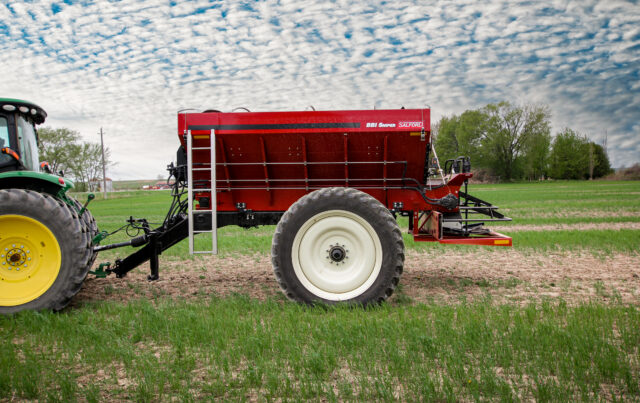As fertilizer prices sailed past their 2008 all-time highs in October 2021, crop producers will need to take a closer look at the profitability of their practices and evaluate ways to save on input costs.
Sectional control fertilizer delivery may be a good place to start looking for savings on fertilizer input costs. Many farms are already employing precision agriculture practices, and section control on seeding and application equipment is becoming more and more commonplace. By targeting fertilizer where it’s needed most while preventing overlap and spreading fertilizer outside of the field, producers may be able to justify precision application equipment costs by reducing their fertilizer use and saving on custom application fees.
There are some spinner spreader models available that offer section control, including Salford’s Sniper. The Sniper Spreader has 12 section control and can spread fertilizer up to 120 feet wide. The spreader has left/right section to make boundary spreading simple, and the 12 section swath helps to reduce overlap in point rows and around irregular fields that contain rivers or sloughs. The swath control also helps to keep fertilizer out of those sensitive areas. The Sniper’s 120-foot application width has the added benefit of completing fields faster and with fewer trips, so there’s less compaction created by the application pass.
Another way to help improve fertilizer effectiveness is to apply the product at the right time in the plant’s development. Plants have continuous and varying nutrient requirements as they grow and become especially hungry when they begin to flower and develop their seed. When fertilizer prices are low, there is a tendency to apply more product in hopes of giving the soil a fertility boost that will last through the whole growing season. However, some fertilizer will be lost to leaching and volatilization. One way to combat fertilizer loss is through the use of time-release fertilizers. These products are being more readily available and more effective. It still may be more beneficial to feed the plant at different times through its lifecycle.
Salford has been developing a series of dry fertilizer applicators for mid-season use. Row crop tires allow the spreaders to get into the field later in the season to apply fertilizer. Salford’s chassis-mounted air boom spreaders fit most major chassis brands and have clearance up to 69 inches, depending on the chassis brand and tire options. The air boom applicators can also be fitted with drop tubes on 30-inch centers, allowing for in-season application below the canopy of standing corn crops.
Another option to help cut fertilizer costs is to look for alternative sources of nutrients. Not every producer has the opportunity to use manure, but in many areas, livestock operations have more manure than they can use in their operation. If manure isn’t a staple nutrient source for a farm business, then custom application is usually the way to go because of all that’s involved in manure handling. However, if dry compost is readily available, there are spreaders, such as Salford’s Endurance model, designed for high output application of dry manure.
Regardless of the size and scale of the crop production operation, producers will have to take a closer look at their nutrient plan, weigh the benefit of extra yield over increased input costs, and consider ways to make their fertilizer applications more effective this season.
